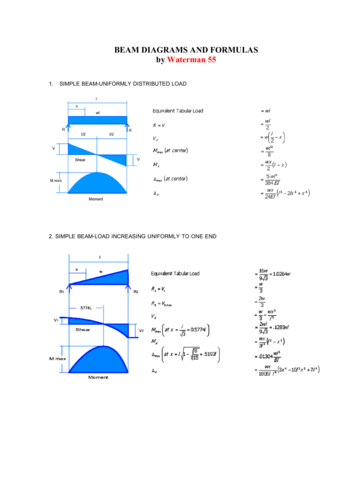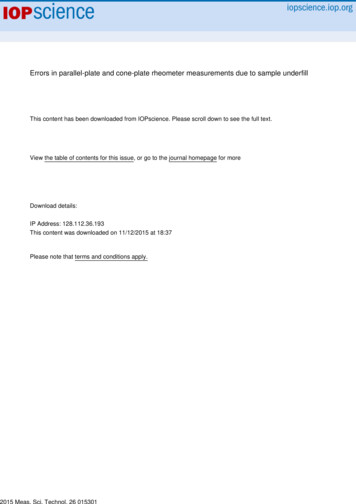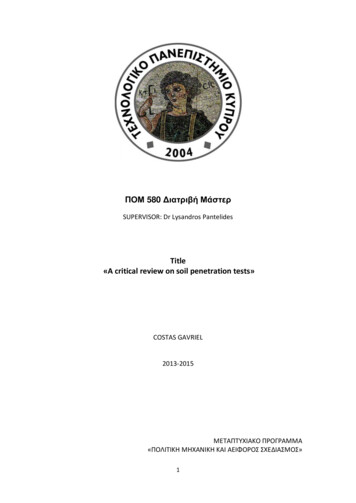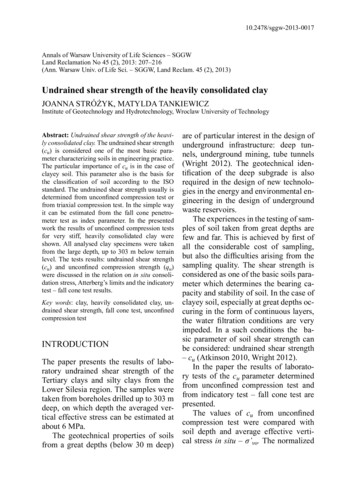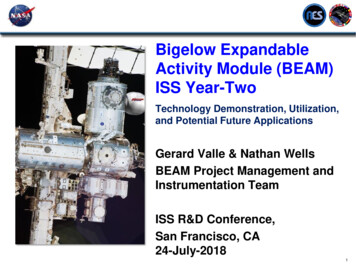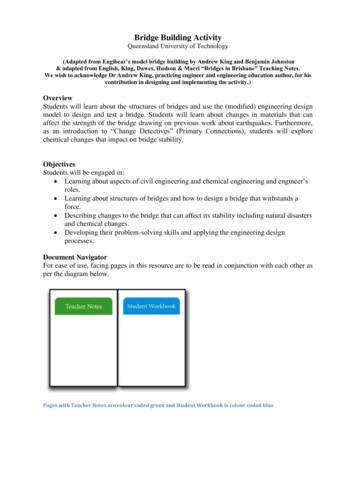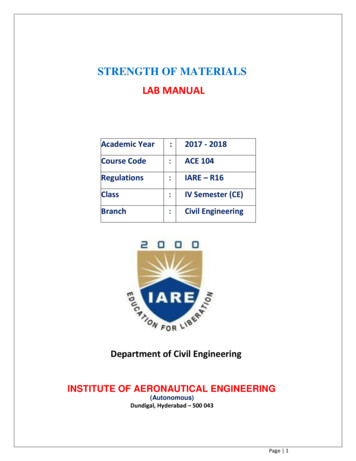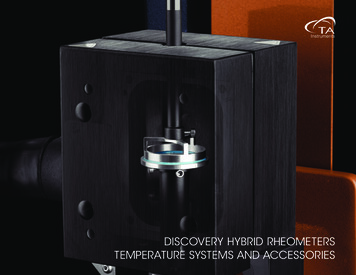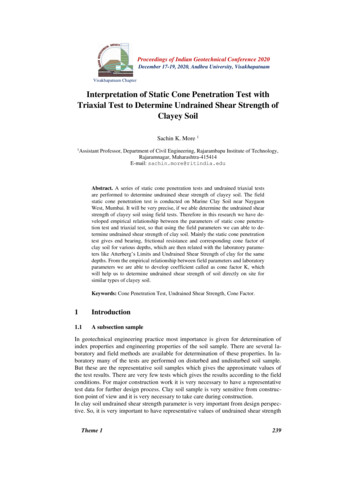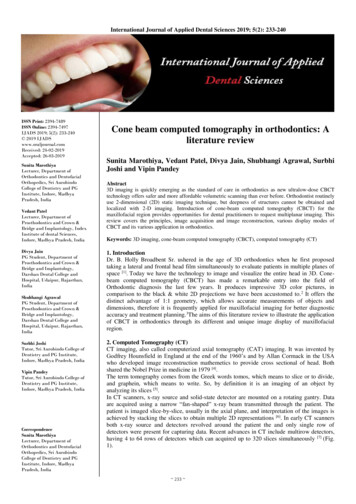
Transcription
1CLINICAL APPLICATION OF CONE BEAM COMPUTEDTOMOGRAPHY FOR EVALUATION OF PERI-IMPLANTBONE THICKNESS AND TEMPORO-MANDIBULAR JOINTIMAGINGThesis of Ph. D. DissertationZoltán Gábor Raskó, MDSupervisor: Dr. Zoltán Baráth, DMD., Ph.D, Habil.Szegedi TudományegyetemFogorvostudományi Kar2019
2List of Publications underlie dissertationI.Z. Rasko, L. Nagy, M. Radnai, J. Piffko, Z. Barath: Assessing of Accuracy ofCone Beam Computed Tomography in Measuring Thinning Oral and Buccal BoneJournal of Oral Implantology 2016 Jun; 42(3): 311-314. IF: 1.212, 2016.II.Z. Barath, Z. Rasko: A Technique for Achieving a Stable Position of the CondylarProcess during Temporo-mandibular JointBritish Journal of Oral and Maxillofacial Surgery IF: 1.260, 2019. – accepted forpublicationOther Publication – MTMT ID: 10068393
3IntroductionAppropriate radiological imaging as well as meticulous physical examination is crucial in thefield of dentistry, implantation and oral and maxillofacial surgery for proper diagnostics andtreatment of the patient. Traditional orthopantomogram can be applied as basic element ofprimary and general imaging, but given its two dimensional feature it would not contributesignificantly enough amount of acquired data from the anatomical structure of the mandibleand maxilla to provide adequate preoperative planning for safe and successful treatment indifficult surgical procedures.The cone beam – or cone shape beam – has been developed primarily for angiographyassessment in the years of 1980 to be possible alternative to traditional fan shape or spiral CTbeams as the whole field of interest can be assessed more accurately in shorter time withsignificant 98% lower exposure of radiation. CBCT is generally used for preoperativeplanning in the field of implant dentistry to evaluate quantity and quality of available bone, todetermine the ideal insertion point of dental implant and its relation to the anatomicalstructures of the jaw, and to define the size and length of the inserted implant.Temporo-mandibular joint (TMJ) pain management is one of the most difficult andcontroversial treatment for physicians. TMJ related pain is common in general population,but only 3-7% of patients attend medical assistance. Imaging of temporo-mandibular jointand its disorders is a fundamental diagnostic step alongside physical examination.Nonetheless physical evaluation of the temporo-mandibular joint can be inconclusive,because the symptoms can overlap each other between internal derangement and dysfunctionresulted of myofacial pain.Some more complicated cases – where significant changes might occur in the bony structureand would be difficult to detect - would require more advanced imaging technologies, such asMagnetic Resonance Imaging (MRI), conventional Computed Tomography (CT) and ConeBeam Computed Tomography (CBCT).CBCT gathered more and more ground in recent times, since it has a significant advantage toMRI, such as this modality is specifically sensible in identification and assessment of boneanatomy, and has the accuracy in structural analysis.The use of hyaluronic acid for TMJ osteoarthritis has been proven effective. Injections of theTMJ are inserted into the superior joint space.
4Determining the correct injection site and adequate needle angle as well as proper depth ofthe injection are essential to the effectiveness of the treatment and could reduce thepossibility to miss the targeted superior joint space, especially in cases of internalderangement, anatomical deviations, developmental anomalies and post-traumatic conditions.There is a constant request for a 3-dimensional, navigated injection process to eliminate risksand potential side effects such as extravasation of injection fluid around the procedure site,facial nerve or preauricular nerve injury, trauma to the temporo-mandibular joint cartilage,preauricular hematoma, transarticular or intracranial perforation or extradural hematoma. Therate of unsuccessful induction or the fracture of the needle tip is between 2-10%.ObjectivesWe wanted to resolve a controversy regarding CBCT:1. We aimed to determine the finite boundaries of this sophisticated instrument ofradiological diagnostics are, in other word what is the minimal expanse of bonystructure which can be safely measured without significant loss of accuracy in thepresence of dental implants.2. Our intention was to demonstrate the actual thickness of bone adjacent to dentalimplant where the CBCT analysis would turn into significantly inaccuratemeasurement. Besides we wanted to gather appropriate information regarding thedistortion of measurement in presence of dental implant. The concept behind our ideawas to furnish the clinicians with an appropriate guideline regarding the thickness ofthe buccal and oral bone that can be measured safely and accurately by CBCT, thusproviding a solid ground for preoperative implant planning and determination ofinsertion place of dental implants.3. We wanted to to demonstrate the accuracy of CBCT in temporo-mandibular jointimaging and assessment.4. We intended to develop a reproducible and easy-to-use method for determining thetemporo-mandibular joint injection point and applying the single-needle technique bystabilizing the condylar process and this way the superior recess of the joint in themost appropriate position.
5Materials and methods1. We examined the peri-implant alveolar bone quantity in a fresh domestic pig mandible,using a young domestic pig (age: 6 months; weight: 140 kg) with healthy muscles, gingiva,and skin. Anatomical features of the pigs are similar to human anatomy, so we used pigmandible to assess the relationship between cortical and cancellous bone, since there is aclose similarity between pig and human mandibles regarding bone density. The domestic pigmandible accurately represents the soft tissue cover of the alveolar bone and attenuates thebeam to soft tissue.All implants were inserted using a full-thickness flap elevation technique with Camlog Surgical instruments (Camlog Biotechnologies AG, Basel, Switzerland) at the bone level, andin some places with minimal submersion (depth: 0.5mm). The position of the implants wasdetermined by the bone volume, as the protocol used defined a fewer than 2 mm distancefrom the implant neck on both the buccal and the oral sides. We chose the molar regionwhere adequate amount of bone appeared to be at disposal and there was no tooth inpresence. The flap elevation was made gently with a surgical scalpel and periosteal elevatorto ensure the correct placement and depth. A constant internal cooling procedure was usedduring the implant site preparation to avoid overheating the implant-bone interface andcausing any measurement distortion. All implant-site preparation steps were made followingthe CAMLOG protocols to avoid any distortion in implant quantity and quality. CamlogScrewline implants were used in different size in the study: 1) 4.3mm diameter, 11mm-lengthon the left side (implant A); 2) 3.8mm diameter, 11mm-length on the right side (implant B);and 3) 3.8mm diameter, 13mm-length on the right side (implant C). In total, 3 implants wereused. Three implants were placed in the molar region of the pig mandible. The implant withthe largest diameter was placed on the left side (implant A); the 2 implants placed on the rightside were slightly thinner (implants B and C). The 2 neighbouring implants located on theright side were placed more than 3 mm from each other, according to surgical protocols.The buccal and the oral cortical plates of the alveolar bone were flattened using a Lindemanbur-drill for forming and shaping prior to implant insertion to ensure uniformity and toincrease the accuracy of measurements. The gradual thinning was executed in 5 phases,before the implants were placed back into the bone, and CBCT measurements obtained aftereach phase. Reinserting of the implants was easy due to features of the Screwline Implants.Primary stability was not our purpose to achieve.
62. We designed a retrospective study to analyze radiographic data from patients undergoingTMJ treatment in 12 cases. Ethical Approval has been obtained from Human InvestigationReview Board University of Szeged (No. 156/2018). We personally performed the injectionprocedures to make sure that data analysis, targeting measurements and the procedure itselfare focused in the same hands.Anatomical impressions were taken of upper and lower jaws the patients, and a dentaltechnician prepared wax rims about the instructions of the physicians to increase stability andaccuracy. The wax was firmly fitted rim into the mouth and applied gutta-percha dissolved inchloroform at the measured and determined Guarda-Nardini injection point with a plugger.We analysed the anatomical structure of the condyle and the joint surface, measuring theirdimensions and their relation to each other on the three-dimensional CBCT scans. The exactposition, depth and angle of the injection were determined with high accuracy and a highreliability of safety using axial and multi-planar reformation (MRP) views.Informed consent was taken after the patient was questioned about detailed medical history.The patients were seated in a dental chair. After sterile standard preparation and draping, theneedle was inserted at the allocated insertion point at the precise angle and depth that waspreviously determined on the 3-dimensional CBCT images with the wax rim in situ.DiscussionThe success of a dental implantation depends on adequate volume and quality of bone,frequently evaluated using 3-dimensional (3D) visualization. Besides it is important to beaware of discrepancies cause by visual artifacts.Thinning of the bone was found to influence the diagnostic accuracy of CBCT. With thinnerbones, the implant site is an air-containing space that leads to over-radiation of the buccal andoral cortical bones. This excess radiation makes the scanned image darker, and themeasurements smaller.Our data show that thinner bone results in greater discrepancy between the measurementswith and without implants, and that these differences are driven by beam-hardening artifacts,which cause gray-level reduction both buccally and orally. Only the thinnest level showeddifferences, and the iCAT software could not handle the small anatomical details. Thus, therewere inaccuracies in defining the border of the thin bone wall.
7The presence of 2 neighbouring implants also affected the evaluation of peri-implant bonequality negatively because of the appearance of the beam hardening artifacts in between twoimplants. The size of the implants did not affect the evaluation of bone quantity.The purpose of thinning the bone was to determine how beam-hardening artifacts caused bythe presence of the implants influenced bone thickness evaluation. We determined thatthinning of the alveolar bone around the implant site reduces the diagnostic accuracy ofCBCT. Further, a thicker alveolar bone (0.72–1.6mm) around the dental implant causes theCBCT to underestimate bone volume by approximately 10%, while rate of theunderestimation for a thinner alveolar bone ( 0.72mm) is approximately 70%. This is asignificant finding considering about 0.9 mm difference in bone thickness can result in 60%inaccuracy.We determined that CBCT has limitation of accuracy due to peri-implant bone thinning.These new findings reflect a different light on pre-implantation planning procedure, since wecould demonstrate the level of underestimation of CBCT can be significantly high in case ofthinner buccal bone, hence clinicians have to consider choosing proper site for implantationafter careful assessment of bone thickness. This way we can declare that the safe thickness ofbuccal and oral bone at the site of desired implantation should be at least 1.5mm, thus thechance of bone underestimation by CBCT can be reduced to less than 10%.After we could demonstrate the measurement accuracy of CBCT between 0.5 and 1.5mmbone thickness, we wanted emphasize its high reliability in the field of TMJ analysis and itsfuture place in the field of diagnostics and therapy planning of temporo-mandibular jointdisorders since the size of the superior recess of the joint is greater than 1.5mm. Applicationof CBCT imaging and analysis gave us a lead to describe a method of TMJ injection withgreat safety considering that the treatment of TMJ disorders are always a challenging task forphysicians, and the techniques and medications used to address patients’ symptoms stillremain a matter of dispute.The use of this method may help to control the injection of hyaluronic acid or other materialsinto the temporo-mandibular joint with severe degenerative lesion.
8The developed method has many advantages:i)The procedure causes minimal trauma to the joint as the risk of intra-articularinjury is reduced to a very low levelii)Postoperative discomfort is tolerable as the extra intra-articular volume dissolvesin a short timeiii)Additional local anaesthetic is not required as a single insertion is needed.Conclusion1. We could demonstrate and prove limitations of CBCT in accuracy of bone thicknessmeasurement. This is a relevant finding hence we could determine the level of bonethickness where CBCT images can reach the point of significant underestimation. Wecould prove that presence of a dental implant has an influence on bone thicknessevaluation in particular if there is more than one implant placed in the bone in vicinityto each other. This can provide a definite base to dentists, dento-alveolar andmaxillofacial surgeons in their service of implantation in consideration of carefulchoosing the site of the planned implant. Since adequate volume of healthy bone iscrucial for successful implant outcome, we are certain that this new information willbe beneficial for providers and patients alike.2. After we presented limitations of CBCT accuracy and have been aware of bonethickness level were the underestimation was significant, we have been certain thatCBCT could be expedient in assessment and treatment of temporo-mandibular joint,as the dimensions of the joint are beyond the underestimation level. We could analysethe anatomical structures of the temporo-mandibular joint utilizing CBCT features.3. We developed a new safe, reproducible technique for single-needle TMJ injectionwith application of Cone Beam CT targeting method which is unique as no similar hasbeen published till now in the literature.4. We could determine the position of the injection point related to the pre-determinedGuarda-Nardini-point, and the exact depth and direction of the injecting needle. Thedescribed technique could make single-needle injection easier to perform asdifficulties resulting from the deviated anatomy can be eliminated and individualvalues can be defined for the injection.
95. The method is reproducible, as all images and data can be stored, re-evaluated andcompared with later stages. The individually fabricated wax-rim can also be stored,thus by repositioning it into the given patient’s mouth the condyles can be stabilizedin the exact same position for subsequent CBCT assessment and single-needleinjection if necessary. This way easier follow-up of the affected TMJ can be reachedas CBCT does not require a large radiation load. This method can be helpful in thetreatment of TMJ disorders, making the approach simpler, easier and morecomfortable for patients and physicians. We intend to further develop and refine ourmethod in the future with addition of a more sophisticated targeting system. Ourmethod can be the foundation for a constantly requested three-dimensional, navigatedinjection process.
10AcknowledgementFirst of all I would like to express my gratitude to my supervisor, The Dean of DentalFaculty, Dr. Zoltán Baráth, who stood on my side with unbreakable faith and helped me onthis road. Our relationship is beyond professional boundaries; our similar path of life andcongenial approach to essential and fundamental matters of life founded a friendship farbefore this project has been started.Special thanks to Professor Márta Radnai for her careful reading, comments and usefuladvises.I would like thank to Professor Ádám Kovács, who invited me to the specialty of Oral- andMaxillofacial Surgery and started my training in this beautiful profession showing mefinesses as a good mentor does. His persistent friendship means a lot.I am grateful to Professor Katalin Nagy, who paved my way when I found myself in a strangenew world after being a Trauma Surgeon, and to date I can respectfully consider her a goodfriend.Let me express my appreciation to Professor József Piffkó, who made possible with histireless work for the Oral- and Maxillofacial Surgery specialty to survive and live on andthen flourish in Hungary, and enabled for me to be the surgeon I am today.I want to thank to all my Colleagues, Doctors, Nurses, Assistants, Theatre Nurses, Porters,my Patients and my Friends for being around me, helping and accepting me sometimes ithas not been easy.I would like to thank to my Parents for bringing me up. You’ve always been and are on myside. I would like to dedicate this work to my Father, who armored me with wise realizationsand has always been optimistic of my professional advancement. I will always be thankful tomy Mother for her temper, attitude and strong personality that formed me the man I amtoday.Last, but not least let me express my deepest gratitude to my Best Friend and Love of my Life,my Wife Melinda, who is always there for me in better or worse and supports me whenevershe feels I am in need of help. I am also thankful to my Children, who gave me the chance toknow what it means to be a Father.
insertion place of dental implants. 3. We wanted to to demonstrate the accuracy of CBCT in temporo-mandibular joint imaging and assessment. 4. We intended to develop a reproducible and easy-to-use method for determining the temporo-mandibular joint injection point and applying the single-needle technique by stabilizing the condylar process and this way the superior recess of the joint in the .
